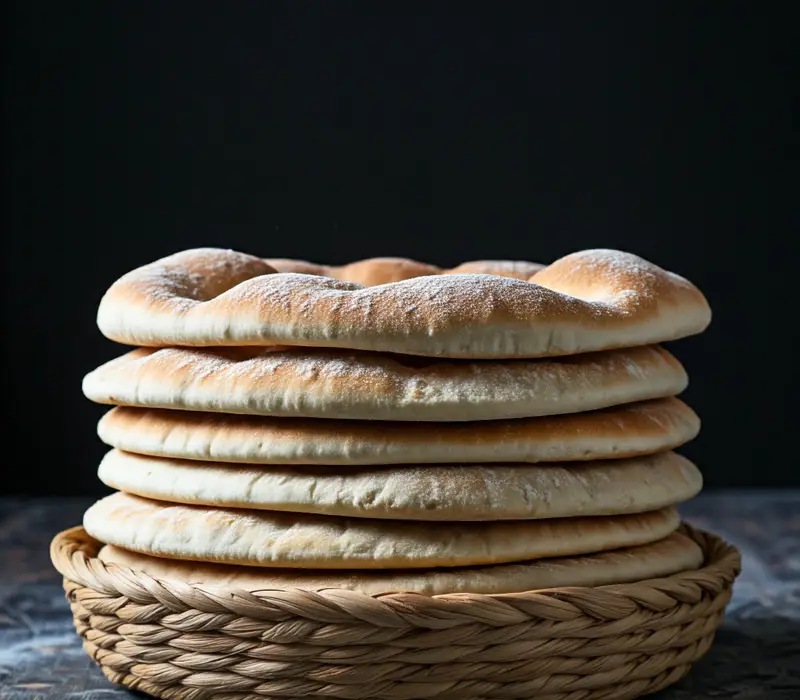Iraqi Samoon Bread Recipe: Ingredients, Preparation

Iraqi Samoon Bread
Samoon bread is a beloved staple in Iraq, enjoyed across households, bakeries, and markets. Known for its distinctive diamond shape and slightly crisp exterior, it plays an essential role in Iraqi cuisine. Travelers visiting Iraq often encounter Samoon at traditional restaurants, where it accompanies flavorful dishes such as grilled kebabs, falafel, or stew. guide to preparing Iraqi Samoon, allowing readers to experience this iconic bread at home.
---
Ingredients for 7-8 Loaves of Iraqi Samoon Bread
To prepare this traditional bread, the following ingredients are needed:
4 cups white flour (sifted)
1 tablespoon instant yeast
1 tablespoon salt
1 tablespoon sugar
Warm water (as needed for the dough)
Optional topping: Sesame seeds or black cumin (Nigella seeds)
These simple ingredients come together to form the foundation of one of Iraq’s most popular breads. The choice of topping, such as sesame or Nigella seeds, adds additional flavor and visual appeal to the bread.
---
Step-by-Step Preparation of Iraqi Samoon Bread
1. Preparing the Dough
Activate the yeast:
Start by mixing the instant yeast with a small amount of warm water and sugar in a bowl. Allow it to sit for 5-10 minutes until the mixture becomes frothy. This indicates that the yeast is active.
Mix dry ingredients:
In a large mixing bowl, combine the sifted white flour with salt.
Incorporate the yeast mixture:
Gradually add the activated yeast mixture to the flour, followed by warm water. Mix the ingredients until they form a dough. The amount of water may vary, so it is important to add it gradually to achieve the right consistency.
Knead the dough:
Transfer the dough to a floured surface and knead it for 8-10 minutes until it becomes smooth and elastic. Proper kneading is essential for developing the gluten, which will give the bread its characteristic texture.
---
2. Allowing the Dough to Rise
First rise:
Place the dough in a lightly greased bowl and cover it with a damp cloth or plastic wrap. Allow it to rise in a warm place for about 1-2 hours, or until it doubles in size.
Punch down the dough:
After the dough has risen, gently punch it down to release any trapped air.
---
3. Shaping the Samoon Loaves
Divide the dough:
Split the dough into 7-8 equal portions, depending on the desired size of the loaves.
Shape the dough:
Roll each portion into an oval or diamond shape, which is the traditional form of Samoon. Make sure the loaves are evenly shaped to ensure they bake uniformly.
Optional: Add toppings:
If desired, sprinkle sesame seeds or Nigella seeds on top of each loaf. Lightly press the seeds into the surface so they adhere during baking.
---
4. Final Proofing and Preheating the Oven
Second rise:
Place the shaped loaves on a baking tray lined with parchment paper. Cover them with a cloth and allow them to rise again for about 30-45 minutes.
Preheat the oven:
While the loaves are proofing, preheat the oven to 230°C (446°F). For an authentic experience,
---
5. Baking the Samoon Bread
Bake the loaves:
Once the loaves have risen, bake them in the preheated oven for about 10-15 minutes, or until they turn golden brown.
Check for doneness:
Tap the bottom of the loaves—if they sound hollow, they are fully baked.
Cool the bread:
Allow the bread to cool on a wire rack before serving. This helps the loaves retain their structure and ensures the crumb sets properly.
---
Serving Suggestions for Iraqi Samoon Bread
Samoon bread is highly versatile and pairs perfectly with a wide range of Iraqi dishes. Here are some popular ways to enjoy it:
With kebabs and grilled meats: The bread acts as a wrap or accompaniment to various grilled meats.
Falafel sandwiches: Iraqi street vendors use Samoon to serve falafel, along with vegetables and tahini sauce.
With stew and soups: It is commonly served alongside hearty Iraqi stews and soups, such as lentil soup.
For breakfast: Some locals enjoy it with cheese, olives, and sweet tea in the morning.
Whether as part of a main meal or a simple snack, Samoon plays a vital role in Iraqi culinary traditions.
---
Tips for Making the Perfect Samoon Bread
Use fresh yeast: The quality of the yeast directly affects the bread’s rise and texture.
Knead thoroughly: Proper kneading ensures a chewy interior with a crisp crust.
Allow enough time for rising: Patience is key when working with yeast dough. Rushing the process can result in dense bread.
Experiment with toppings: While sesame and Nigella seeds are popular, you can try other toppings like poppy seeds or coarse salt.
---
Samoon Bread in Iraq
Samoon bread holds a special place in Iraqi culture, not only as a dietary staple but also as a symbol of hospitality. It is common for households to serve fresh Samoon to guests, reflecting the importance of sharing food. In Iraq, bread is considered sacred, and wasting it is frowned upon.
Moreover, the process of baking Samoon—whether at home or in traditional bakeries—brings communities together. The smell of freshly baked bread wafting through the streets is a familiar and comforting aspect of daily life in Iraqi cities.
Iraqi Samoon bread offers more than just sustenance—it provides a window into the heart of Iraq’s culinary heritage. By following this recipe, travelers and food enthusiasts can recreate the experience of enjoying this iconic bread from the comfort of their homes. Whether paired with savory meats, hearty stews, or served as a simple breakfast, Samoon is sure to leave a lasting impression on anyone who tries it.